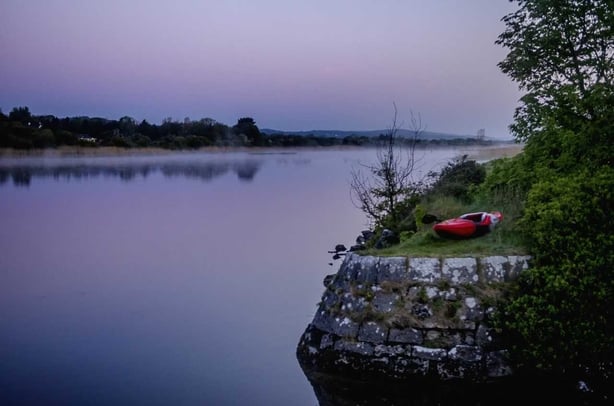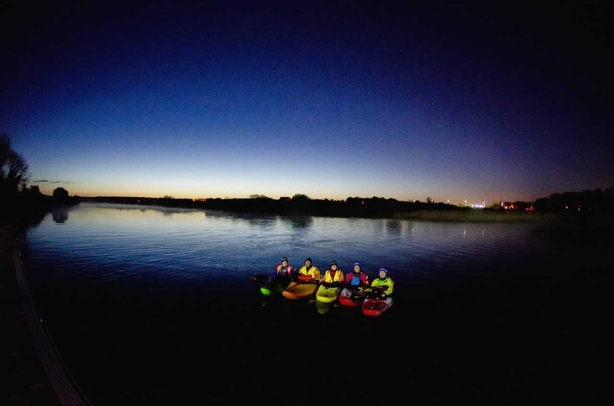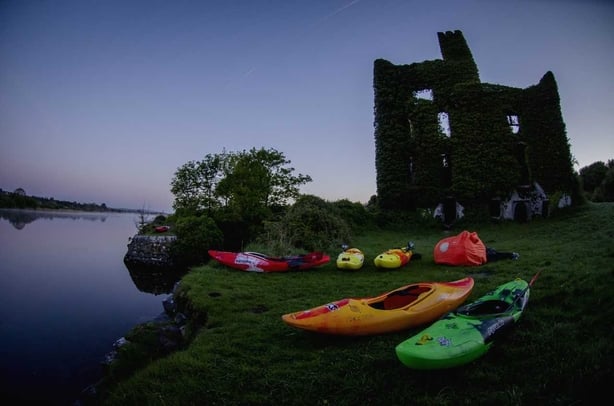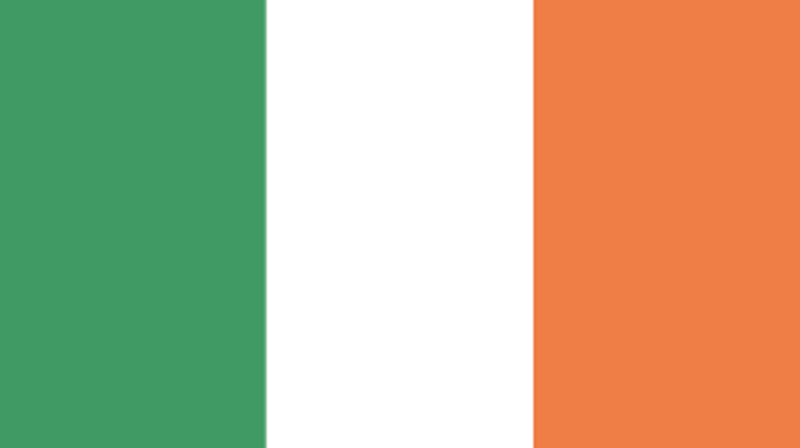Country: Ireland

Organisation: RTÉ Radio 1 & BirdWatch Ireland
Location: CORK - Cuskinny Marsh Nature Reserve, Cobh
Cuskinny Nature Reserve, near Cobh, County Cork, Ireland is managed by Birdwatch Ireland (BWI). The land is privately owned, and comprises about 12 ha of land located along the lower reaches of the Ballyleary Stream on the Great Island in Cork Harbour. The reserve includes a mixture of lake, swamp, grassland and woodland habitats and is of local nature conservation importance. It is also an important local amenity and is used by local schools for educational purposes. For further information about Cuskinny Marsh Nature Reserve, and the different birds that can be found there, visit www.cuskinnynaturereserve.com. To view more photos of Cuskinny, click here.
On Air: Derek Mooney, Dr. Richard Collins, Niall Hatch

Derek Mooney: One of Ireland's best-known and highly decorated broadcasters, Derek Mooney has been leading the development of wildlife radio broadcasting here for over two decades. His achievements in the natural history field include Habitats, The Nature Line, Nature Trails and Mooney Goes Wild On 1, all for RTÉ Radio 1, BioBlitz Live, Wildtrack and Nature Live on RTÉ TV, and Nature Detectives for the BBC. In February 2015 Derek started his new role as Executive Producer for Nature programming on RTÉ Radio.
Dr. Richard Collins: Born in Limerick in 1944, Richard holds a BE in Electrical Engineering, a BA in Philosophy and English and a PhD in Zoology. He was Honorary Secretary of the Irish Wildbird Conservancy (now BirdWatch Ireland) from 1977 to 1982 and is a BTO bird ringing permit holder. A weekly columnist on environmental topics with the Irish Examiner since 2002, he teaches at the Adult Education Department, University College Dublin, where he is known for his quirky and colourful lecturing style. A former vice-president of Dublin Zoo and a former Governor of Fota Wildlife Park, he joined RTÉ’s Mooney Goes Wild team in 1995. Specialist interests include Mute Swan biology, oiled seabird rehabilitation and philosophy of Nature. Ornithological papers published in Waterbirds, Ringing & Migration, Biology & Environment, Wildfowl and Irish Birds. Engineering papers in the Proceedings of the Institute of Electrical Engineers (London), Networks 1995 (Budapest) and Technical Journal (Dublin).
Niall Hatch: A keen birdwatcher since very early childhood, Niall is currently the Public Relations, Branches & Development Officer for BirdWatch Ireland, Ireland's largest and most active conservation NGO, and, amongst other things, is the editor of its Wings magazine. He has worked on bird conservation and public education projects on six continents, and has a special interest in island endemic species and evolution. He is also a qualified solicitor and is well-versed in wildlife protection law. A veteran both of the Mooney Goes Wild panel and the Dawn Chorus, he has a particular passion for bird song. For more information about BirdWatch Ireland, visit www.birdwatchireland.ie.
Key Species: Blackbird, Robin, Song Thrush, Wren, Dunnock, Woodpigeon, Goldcrest, Wren, Rook, Hooded Crow, Pheasant, Chaffinch, Greenfinch, Great Tit, Blue Tit, Coal Tit, Treecreeper, Chiffchaff, Willow Warbler, Sedge Warbler, Swallow. Also - Moorhen, Coot, Little Grebe, Shelduck, Mallard.

Location: DUBLIN - Luttrellstown Castle Resort
The history of Luttrellstown Castle goes back to early 1200’s. Geoffrey Luttrell purchased the estate for 20 ounces of gold! The name Luttrell is from French "l’outre" meaning otter. Visitors include Queen Victoria, Fred Astaire, Paul Newman, President Reagan, Prince Rainer & Princess Grace, King & Queen of Denmark, David & Victoria Beckham (who famously were married at the venue in 1999).
The grounds stretch to almost 600 acres and include a 13-acre lake, Doric Temple, waterfall, a boat house, an ice house, a American walk, a glen, a folly and an obelisk. Kingfisher and Dipper nesting indicate good water quality. There is a giant sequoia (the second largest in Ireland) and there are a number of champion trees on the estate. Luttrellstown Castle and grounds have five of Ireland’s bat species, and pine martens are also present.
On Air: Terry Flanagan, Eanna ni Lamhna & Eric Dempsey

Terry Flanagan: A trained biologist, Terry is the senior Science teacher in Moyle Park College and has been teaching there for 40 years now. He is also a senior Leaving Certificate Biology examiner. He is responsible for the setting up of Senior and Junior Science clubs in the College encouraging many students to follow a Science career. He has contributed enormously to wildlife organisations over many years. He is a past Secretary of the Institute of Biology (professional biologists in Ireland). Terry is presently the Science and Wildlife reporter on Mooney Goes Wild, and has been since the programme went on air.
Eanna ni Lamhna: Eanna holds degrees in Botany and Ecology from UCD as well as the H. Dip. Ed. She started her working life in An Foras Forbartha where she was in charge of the Irish Biological Records Centre, doing the initial work on mapping the distribution of Irish plants and animals in the 1970’s and 80’s. She has worked as a lecturer in DIT for the past 20 years teaching the principles of sustainable development to both post graduate and undergraduate students. She is a former president of An Taisce and is currently Vice-President of the Tree Council of Ireland. She is the author of several books on wildlife, the most recent being Wild Dublin (O'Brien Press), and Wild Things At School (Heritage Council). Her distinctive Co. Louth accent makes hers one of the most recognisable voices on radio.
Key Species: Blackbirds, robins, wrens, tits, thrushes, blackcaps, pheasants, jays, and hopefully buzzards. As there is a stream running through the woodland where they are based, they may get kingfisher and dipper.

Location: CORK - Fota Wildlife Park
Fota Wildlife Park, part of the Zoological Society of Ireland, is located on 100 acres at Fota Island 10km east of Cork City and has an annual attendance of 440,000 visitors. It is currently the second largest visitor attraction in Ireland outside of Leinster. Fota Wildlife Park’s vision is to inspire people to understand and conserve the biodiversity of our natural world. The Park’s core values of conservation, education, research and entertainment have ensured that we are uniquely placed to foster greater public understanding of the threats to plant and animal habitats and decreasing global biodiversity. Fota Wildlife Park has made considerable investment in the past 5 years upgrading its infrastructure and is currently near completion of an additional 27 acres development that focuses on Asian animals and plants.
On Air: Bláthnaid ní Chofaigh & Sean McKeown
Key Species: Ostrich

Location: COUNTY CLARE - The Burren

Susan will be based a few kilometres outside Kilfenora in the Burren in North Clare. This is an area with conifer forests, bog and farmland. Here Cuckoos, just returned recently from Africa, can be seen perched up high on their conifer calling posts. The surrounding bogs are home to their favourite host species in Ireland, the Meadow Pipit.
On Air: Susan O'Donohoe

Susan O'Donohoe is a bird conservationist and licensed BTO bird ringer. She has worked all over the world with birds such as Long-eared Owls in Serbia, Woodpeckers in Oregon, Honeycreepers in Hawaii and Kingfishers in Saipan. She is passionate about studying birds and working to conserve them and their habitats. She is also a wildlife researcher for nature documentaries and has worked on many productions including the TG4/BBC production Eire Fhiain/Wild Ireland.
Key Species: Common Cuckoo

The Countryside Bird Survey is a BirdWatch Ireland survey, and is largely a volunteer-run project. Since 1998, 43 different bird species have been recorded in Susan's 1km CBS, square which is not far from her current location.It's no surprise that it holds good cuckoo numbers as along with Connemara, the Burren holds the highest density of breeding pairs in the country.

Location: COUNTY DONEGAL - Tory Island
Tory Island had 16 calling male corncrakes in 2018 and 17 calling in 2017. Nettle Early-Late Cover patches currently yields about 80-100% nettle cover on Tory. We are hoping, with favourable weather conditions, there should be good nettle growth before the majority of the birds arrive. Last year some of the birds also used oats and potatoes for cover on Tory Island.
On Air: Liam Loftus

Liam Loftus: Supervisor for the Corncrake Project and Fieldworker for the West Connaught Region
Key Species: Corncrake
Corncrakes are migratory, wintering in sub-Saharan Africa, mostly in south-eastern countries like South Africa, Zimbabwe, Zambia and Tanzania, where grassland habitats are favoured. They begin arriving back on their breeding grounds in April and May and seek out tall vegetation for nesting habitat. Throughout the breeding cycle they require continuous cover of tall vegetation and are most frequently found in annually harvested meadows, or unfertilised, marginal and damp grasslands.
In the early stages of the breeding season, birds favour nettles, yellow flag iris and reed beds for cover when the surrounding grass is short but by June, birds will usually begin moving into surrounding grasslands.
Males attract mates with their loud rasping call, usually heard during the night from midnight onwards. The female is attracted by the call and makes a nest in the vicinity of a calling male. She incubates a clutch of about 8-12 eggs in a shallow nest on the ground concealed in tall vegetation. First brood chicks are accompanied by the female for about 12 days before she abandons them to lay a second clutch. Peak hatching dates of first and second clutches are mid-June and late July/early August, respectively so flightless chicks from second broods are still present on breeding grounds into September.
Conservation efforts focus on working with landowners to delay mowing until after the peak of hatching of second clutches, as well as to mow fields from the centre outwards which allows chicks to escape. The Corncrake is on the Red List of Birds of Conservation Concern in Ireland due to historical declines.
In Donegal, the proportion of calling males on offshore islands relative to the national population has increased significantly since 2000. An average of 37% of the national population was on islands from 2000-2008 and this increased to 55% from 2009-2017. The reasons for the increase on these islands may be due to good productivity as a result of less mowing activity during the breeding season and reduced disturbance.

Location: DUBLIN - Tallaght - June Rodgers' Cottage
Comedian and nature lover June and her husband Peter live in a cottage that is 120 years old. She has two foxes, a hedgehog, frogs, blue tits, magpies, wrens, house sparrows – and then on the "night shift", she has field mice that visit the garden. She has a bird feeder, and uses seed such as niger to entice the smaller birds. June’s love of the garden came from her dad Alex, who also grew veg. It has evolved into a gorgeous oasis of calm and colour, particularly in the summer, when everything is in full bloom. June’s favourite plant is a stunning creamy-white hydrangea in her front garden called Annabella, that people often call to the door and ask her about. She also loves verbena, as it attracts butterflies, and as a famed nature and animal lover, she tries to attract some wildlife into the garden as well.
On Air: June Rodgers & Fergus Sweeney

June Rodgers has been a very popular figure on the Irish comedy circuit for 30 years. She started performing on the John Player Tops of the Town circuit, and once Ireland got a taste of her immense comedic talent and brilliantly funny characters, she was able to leave the day job behind and hasn’t looked back since. Listeners to the Joe Duffy Liveline radio show will be familiar with her regular slot on the Funny Friday shows, and she has been a star of TV, radio, film and theatre for the past three decades.
Key Species: Blackbird & Robin

Location: DUBLIN - Kilmainham - Rory Cowan’s roof garden
Rory has a couple of bird feeders on his roof garden. He has planted plants to attract bees. Rory would love a hedgehog as they’re great at garden maintenance including slugs, but he feels his garden wouldn’t be big enough to sustain one.
On Air: Rory Cowan & Fergus Sweeney
Key Species: Thrush, Robin, Magpie, Wood Pigeon

Location: COUNTY GALWAY - Menlo Castle on the River Corrib
Menlo Castle is a 16th century castle on the banks of the River Corrib, it is a 2km paddle in a kayak from the city, and takes about half an hour to get there. It was home to the Blakes who lived there until 1910. It burned down in 1910 and the ruin is still there today. Barn owls have been known to nest in its ruins. There is a lovely woodland surrounding it with lots of wild garlic growing in it giving a lovely fresh smell.
On Air: Dónal Glackin


View of the Corrib by Dónal Glackin

Members of the Galway Kayak Club. Photo by Dónal Glackin

Kayaks resting beside Menlo Castle. Photo by Dónal Glackin
Dónal Glackin: Dónal is a freelance photographer based in Galway. He does a lot of kayaking with the Galway Kayak Club and they regularly run club trips to the Upper Corrib where they see lots of bird life. Dónal has been living in Galway for 5 years.
Key Species: Starlings, swans, coots, moorhens, possibly barn owls.

Location: COUNTY WEXFORD - Great Saltee Island
There are over 220 species of birds recorded in the Saltee Islands. The three main groups on these islands are breeding sea birds, resident land birds and migrant birds. Most day trippers and bird watchers enjoy viewing the Gannets, Puffins, Guillemots, Razorbills, Fulmar, Razorbill, Guillemot, Manx Shearwater, Kittiwake, Great Black Backed Gull.
On Air: Sean Pierce
Sean Pierce: Sean works as Physical Education and Geography teacher at Balbriggan Community College. He's a founder member of the Fingal Branch of Birdwatch Ireland, and has served nationally on the Executive of Birdwatch Ireland. He has a life long interest in natural history and specialise in bird conservation projects, surveying and censusing a wide variety of bird species particularly on the offshore islands of Ireland. He has a particular interest in the Roseate Tern Conservation Project on Rockabill, and students and staff at Balbriggan Community College produce Nestboxes to support the project. He is a Co-Director of Shearwater Sea Kayaking, which specialises in training people is sea kayaking skills to expedition and enjoy Ireland's offshore islands.
Key Species: Gannet
The sounds from the breeding colony on Great Saltee is the intended backdrop. The Gannet returns to breed in large numbers on Great Saltee after being at sea all winter. Their courtship displays and vocal calling is one of Ireland's best natural history experiences.

Location: COUNTY WESTMEATH - Mullingar
On Air: Brendan Mulligan

Brendan has a farm outside in County Westmeath, with a mix of commercial forestry, old woodland and open farmland. The farm is not certified organic but has operated as organically as possible for generations. The benefits are evident in the range of biodiversity on the farm. He has a keen interest in encouraging and re-introducing native and farmland birds through traditional farming methods. He is presently hoping to attract a swift colony in the yard buildings through sound recordings played at dawn and dusk.
For the Dawn Chorus, Brendan hopes to have the Great Spotted Woodpecker, which he recently recorded for the first time drumming there on a young oak tree. He also has a pair of nesting barn owls, long eared owls, calling cuckoo at the minute, and raucous ravens!
Key Species: Woodpeckers and owls

